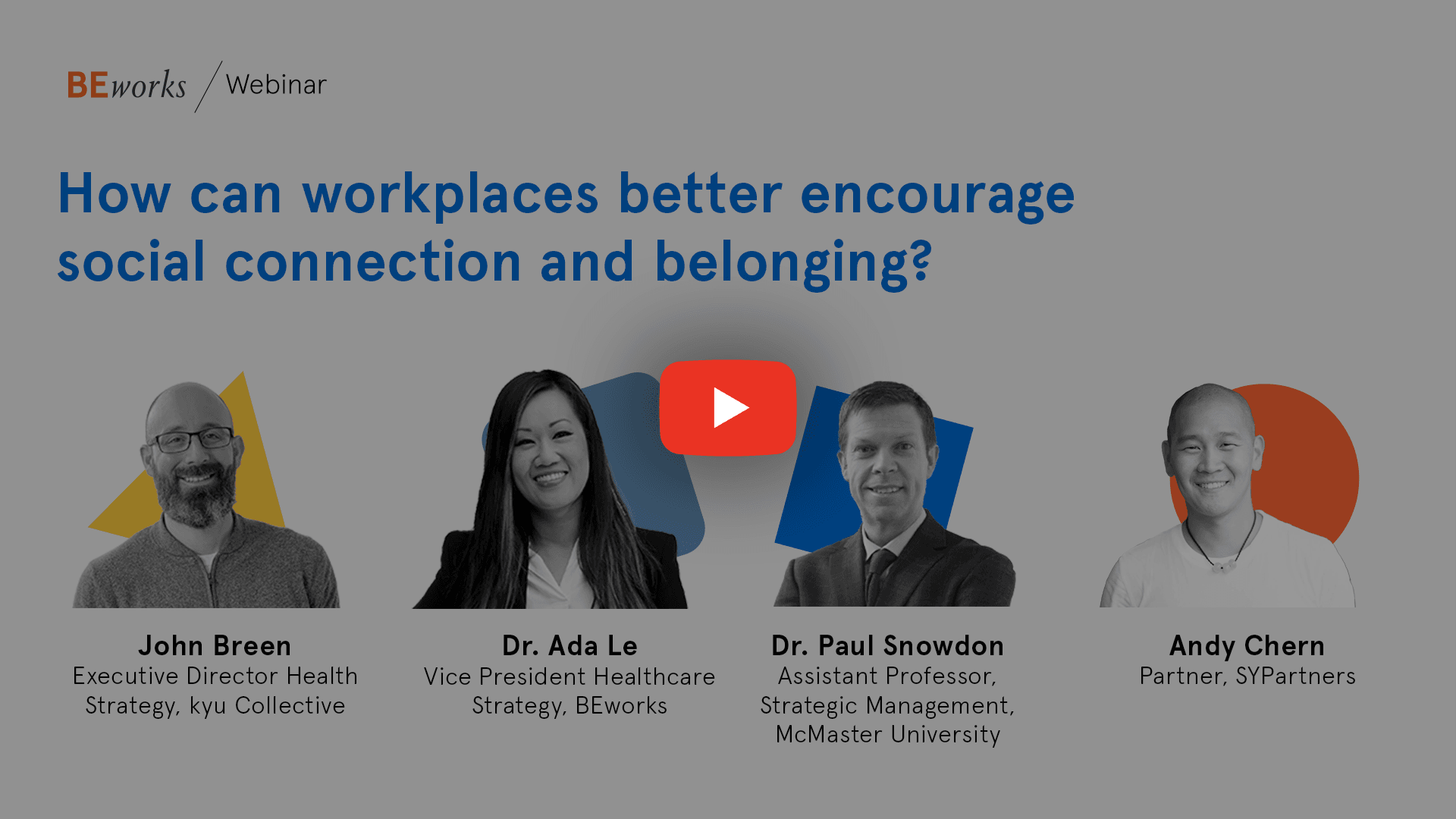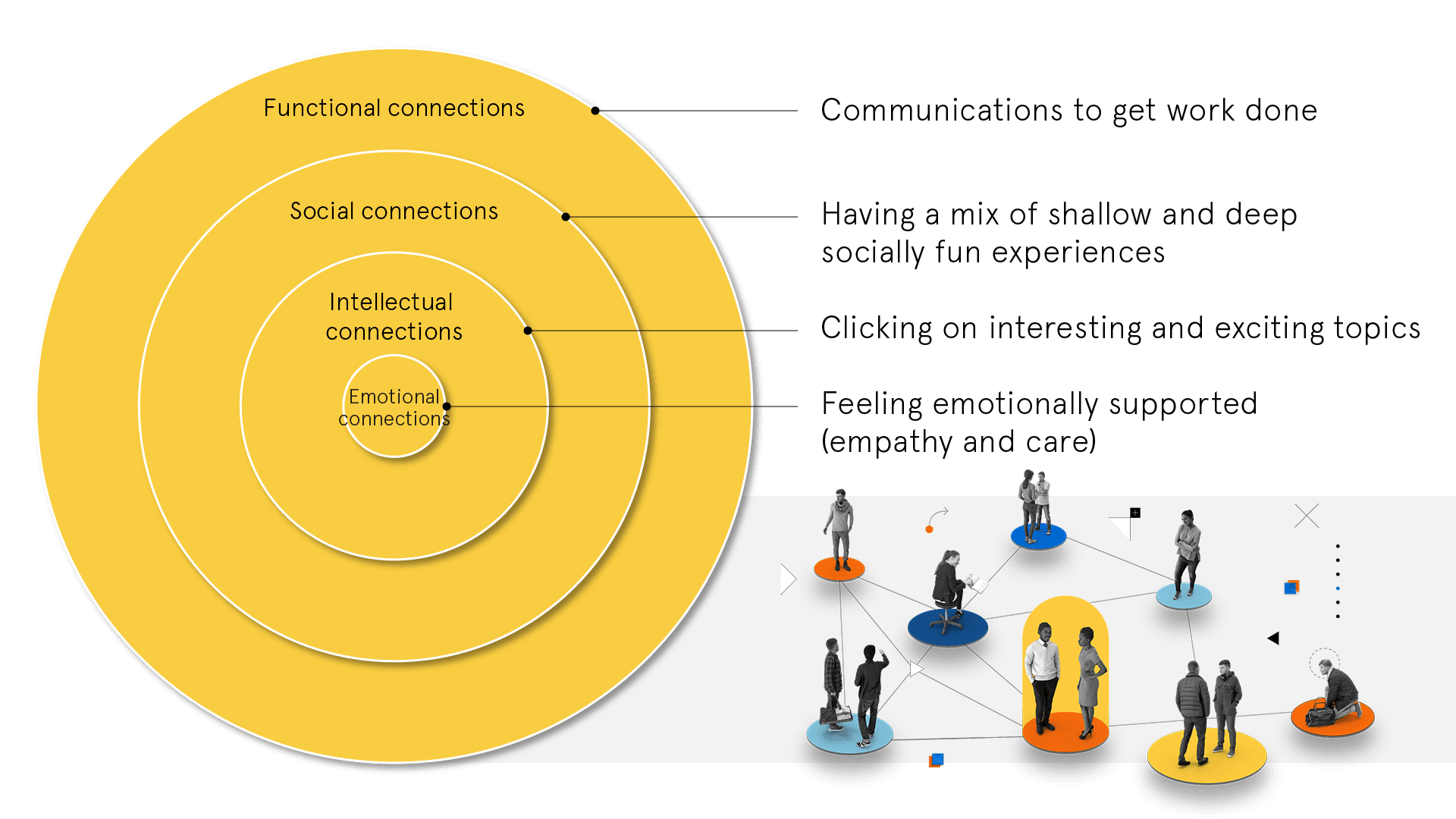

Employee Well-being
Experts discuss how workplaces can facilitate deep and meaningful social connections beyond mere face-to-face interaction to overcome an epidemic of loneliness among workers

Employees are feeling lonelier now more than ever. Studies found that 82% of workers reported feeling lonely at work and that 49% felt lonelier after the pandemic. The U.S. surgeon general went as far as to declare it a “loneliness epidemic,” back in 2017.
The Covid-19 pandemic accelerated digital and remote work adoption, but also isolated employees from emotional human connections. The rapid shift from physical to virtual reality, among other workplace stressors, severed much of the physical spaces (and downtime) for peers to connect, leading employees to feel lonelier.
Businesses are still grappling to find a solution. Organizations made recent strides for more face-to-face interactions, such as in-office mandates to overcome feelings of loneliness among employees, but BEworks VP Ada Le doubts this will be enough to instill a deep sense of belonging.
So, what is?
Academic and creative experts from BEworks, kyu Collective, SYPartners, and McMaster University discuss how to foster meaningful social connections in the workplace at a time of rapid technology adoption.
The panelists are:
Ada Le, behavioral scientist and VP of health strategy at BEworks.
Paul Snowdon, professor of Strategic Management at McMaster University.
Andy Chern, partner at SYPartners, previously principal and managing director.
Moderated by: John Breen, executive director of health strategy at kyu.

Ada: In general, loneliness is the negative feeling we experience when our needs for rewarding social contact or relationships are not met. Whereas employee connection is the availability of designated downtime and workplace features to overcome isolation. Employee loneliness is known to reduce worker performance, productivity and turnover rates.
We can break this down into four levels of connection: functional, social, intellectual, and emotional. Think of it as an onion. At the outermost part are “functional connections” that is connections made to get work done. At the center are “emotional connections,” which are feelings of emotional support such as empathy and care.

Another important thing is to make space, but also time. Re-designing the environment doesn’t just mean changing the physical space, it also means changing the time that people have.
In our work with BEworks’ Drs. Matthias Berkes and Mona Zhu, we found that if people have a workload that is too heavy or an unconsolidated workday where time isn’t chunked, it's harder for them to make time for better connections. This is known as the scarcity of time.
Social connections are best done starting from the top, with senior leaders as role models. They set the tone that gets carried out through the organization.
Paul: Loneliness matters because we are at the onset of the 4th industrial revolution of interconnected physical, digital, and biological spheres. Transformative technology and generative AI are happening left, right, and center. But what about the people? My perspective is that human, not tech-driven design should be leading that transformation.
Andy: It’s fascinating to see the repercussions of loneliness. The pandemic has illuminated things. We took informal conversations for granted pre-pandemic. I like to see these as withdrawals and deposits. When we’re together, during coffee chats and such, we are making [connection] deposits. Now, we are heavy on withdrawals, and these deposits are more functional.
“Business strategy needs to be enabled by its people.”
Ada: I think there is some recognition that it is a problem. I am not entirely sure that business leaders see that the crux of the problem is not enough focus on the people. At the very least they are seeing some of symptoms: employee dis-engagement and burnout, but not the cause of it.
Our hunch is that solving for human connection will build greater employee resilience and creativity. The winning formula is the shift from operational to creative competitiveness.
Paul: The recognition of the problem is lumpy. If you think of organizations and their structure, they are very different. Business strategy sits at the intersection of the external environment and the internal capabilities needed to capitalize on it.
Successful leaders recognize that their business strategy needs to be enabled by their people. When they look at the capability gaps of their people, which can be from the creative, technical, or collaborative perspective, that’s where the catalyst for transformation is.
Ada: Another tension is quantity versus quality of connections; we conflate them both. We often think theat better connections mean more events, but we need to find the right balance between how much we do and what makes those moments really great.
Paul: I see two tensions. One is a desire for change and innovation versus the predictability of the status quo. The second is a power dynamic: the desire to empower creativity and the desire to control and manage.
“If you want your people to care for your customers, they need to feel cared for.”
Andy: Before jumping to the solution, we want to understand what the niche of the problem is, in the sense of: what a meaningful connection is to your people, and what a meaningful connection is to your organization. I think at SYPartners we are loathed to think there is a suite of magical tools that work for everyone.
And I think that when using language or social practices, there is a real risk of the “say-do gap.” You can do the grand gestures, but if you can't deliver on those expectations, that’s a problem. In our work with a large operational company looking to provide more care in customer transactions, we learned that “if you want your people to care for your customers, they need to feel cared for.”
“To understand the problem, you have to hear your people.”
Paul: Start small. There is no silver bullet.
In one study I did with Rogers telecommunications, they distilled their people’s needs into two mantras: what do we need to do to keep people connected, and what do we need to do to keep people safe right now. This management conversation can happen at any time and empowers people to look for solutions.
Andy: Leaders often forget, lose sight of, or undersell listening. Listening is a form of engagement. There is an urgent desire to act, but I’m still surprised by active listening and what it yields. To understand the problem, you have to hear your people.
For more information about how BEworks can help your organization contact us here.